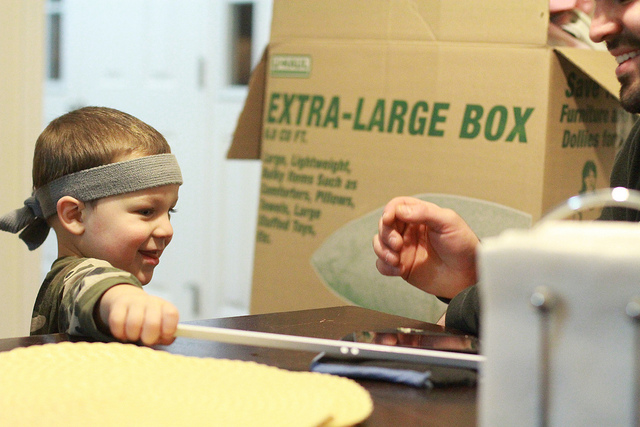Unlock the Magic in Your Story Now
Get the Free 20 questions to Ask Before Launching Your Idea workbook when you sign up for occasional updates.
Get the Free 20 questions to Ask Before Launching Your Idea workbook when you sign up for occasional updates.
Do Your Actions And Story Align?
filed in Marketing, Storytelling, Strategy
 Have you ever seen the somber, suited doorman at Cartier chasing a thief, searching a customer’s bag or stopping a young woman from entering the store? Me neither.
Have you ever seen the somber, suited doorman at Cartier chasing a thief, searching a customer’s bag or stopping a young woman from entering the store? Me neither.
If he’s not doing that then why is he there?
Does the sales assistant at MontBlanc really need to wear a white glove to remove the pen cap before he hands it to the shopper to try?
Should the yellow sale signs at the $2 discount store really be that bright?
Why don’t Starbucks coffees come in plain old small, medium and large, instead of Tall, Grande, Venti?
Is there really any need for the velvet rope customers line up behind to buy coffee pods at Nespresso?
What difference would it make if Apple renamed the ‘Genius’ a customer service technician?
There’s a reason a hand crafted leather bag can’t be shipped in cheap plastic packaging and a drink in the bar with the best view of Hong Kong can’t cost less than $20.
Everything, from the words you use in an automated email, to colour of your packaging is your brand story. Every detail needs to be consistent with the story you want your customers to hear and believe.
Tomorrow is the last day to register for The Story Strategy Course, we start this week.
Image by Garry Knight.
Share this article
The Simplest Way To Add Value
filed in Marketing, Storytelling, Strategy
 We just moved house. You can probably empathise—so many logistics to arrange and tiny details to keep in your head, no matter how much help you have.
We just moved house. You can probably empathise—so many logistics to arrange and tiny details to keep in your head, no matter how much help you have.
By 3pm on moving day we had Internet (no mean feat). At about 9pm we realised there was no hot water. Too late to contact anyone of course, so it was cold showers all round. But hey, we had Internet. Day two involved trying to reset the boiler and finding the contact details of the guy who had installed it. Two calls, some over the phone instructions later and we were up and running.
While I was standing in that cold shower it struck me that it would be very easy for the real estate agent who sells a property to add value to the transaction for both buyer and seller, by thinking about what the customer is about to do next. The agent could create a simple fill-in-the-blanks pro-forma inviting the seller to list contact details of tradespeople who have worked on or maintained the property, anyone from the window cleaner to the company who installed the security system. The agent would also avoid having to pick up enquires about these things in the weeks following the sale.
Our customer service often stops at the point of sale or delivery, when we think the transaction has ended. It doesn’t have to. Imagine a world where little boys were happier on Christmas day because people were reminded to buy batteries for the remote control car they ordered. A place where no new lamp arrived without a light bulb and nobody had a cold shower on moving day.
What is your customer about to do next and help him to do it?
Image by Kelly Polizzi.
Share this article
The New Rules Of Email Marketing
 The old rules are broken. Familiar email marketing tactics might enable us to extract one more sale, but they are definitely not designed to respect our customers—the people who pay our bills, the same people we hope to matter to. They are busy and smart. We should treat them that way.
The old rules are broken. Familiar email marketing tactics might enable us to extract one more sale, but they are definitely not designed to respect our customers—the people who pay our bills, the same people we hope to matter to. They are busy and smart. We should treat them that way.
THE NEW RULES OF EMAIL MARKETING
1. If you wouldn’t do it face-to-face don’t do it in an email marketing campaign.
You wouldn’t dream of knocking on the same customer’s door seven times in ten days (or three times in one day). Why is it okay to do this via email?
2. Consider the people who have given you permission to email them as individuals, who trust you.
Using collective terms like ‘my list’, ‘my followers’ and ‘my community’ distances you from the experiences, problems and feelings each potential customer has. Generalisations imply ownership, not leadership and addressing the collective stops you from creating the kind of messages, products and services they want.
3. Run everything through a generosity filter.
Ask yourself if your tactics are customer-serving or self-serving. Check that you’re not justifying a deluge of emails (that will generate more sales), by rationalising about dissatisfied customers missing out. Make giving before getting your goal.
4. Don’t say anything in an email (marketing campaign or otherwise), that you wouldn’t say to the reader’s face.
This is harder than you think. It’s easy for exaggerations to morph into half-truths or worse when you’re not looking someone in the eye. Act like you’re looking them in the eye.
5. Evaluate whether your email marketing strategy is aligned with your big picture business strategy.
Is attracting and converting ‘the most people’ today your number one priority? Why?
If not, what is?
6. Choose your metrics wisely.
When you focus on the sales numbers alone, it makes your marketing tactics appear desperate and stifles your creativity. Make what you measure reflect your values and trust your instincts.
7. Spend twice as much time finding ways to see your customers, as you do asking them to see you.
This blueprint is a good place to start.
8. Don’t feel compelled to follow the crowd.
You don’t have to use the tactics that other marketers use. Three tier pricing that gives the illusion of choice, or untruthfully creating a false sense of urgency or scarcity to make people fear missing out, will get you more sales today, but maybe you’d rather play the longer game?
Image by Axel Hartmann.
Share this article
The Opportunity Equation
filed in Marketing, Storytelling, Strategy
 In order for a business to take advantage of an opportunity four factors must be in place.
In order for a business to take advantage of an opportunity four factors must be in place.
The formula looks like this.
VISION + RESOURCES + SKILLS + PLAN = OPPORTUNITY REALISED
An opportunity can only be realised when you have the vision to recognise it and the resources, skills and plan to execute on it. And yet many companies with these resources who see opportunities don’t take advantage of them.
Why is that?
It turns out that the most important driver of change is the willingness to make it happen. If everyone concerned with realising the opportunity doesn’t want get behind it, then the chances of success are slim.
Understanding the problem to solve is one thing. Caring enough to want to do it is key.
Light bulb moments are overrated.
Image by Jens Schott Knudsen.
Share this article
Want To Vs. Have To
filed in Storytelling, Strategy
 The famous fashion designer doesn’t have to pay a fair wage to the workers in the Indian village, who hand bead the $600 dresses she sells to affluent Melburnians. Her customers would never know—and yet she does.
The famous fashion designer doesn’t have to pay a fair wage to the workers in the Indian village, who hand bead the $600 dresses she sells to affluent Melburnians. Her customers would never know—and yet she does.
The busy graphic designer doesn’t have to make suggested improvements to the slide deck he’s working on. His client will be quite happy with the original version—and yet he does.
The tired call centre operator doesn’t have to hold while the customer rummages through his records for the receipt he’s clearly lost. She could keep working to time and towards her performance indicators—and yet she does.
The tram driver doesn’t have to get out of his seat to help the elderly lady lift her heavy shopping up the steps. That’s not in his job description—and yet he does. Then a passer-by gives him an ovation from the street and yells, “well done driver”. The driver grins and everyone on the tram smiles at the reciprocal generosity and joy.
We each have hundreds of tiny choices to make every day. How we choose changes everything about who we are and what the world perceives—not just about us as individuals, but about our businesses and the world we are creating together.
What did you do today for money? What did you do for love?
Image by Garry Knight.
Share this article
How Will You Get To Where You Want To Go?
filed in Marketing, Storytelling, Strategy
 There are always things we know we’d like to change or improve about our businesses.
There are always things we know we’d like to change or improve about our businesses.
Often we’re just not sure what’s missing, how to begin or even where to start.
To make change happen you need to have the vision to know where you’re going, the skills and resources that enable you to get there and a plan to drive it forward.
The difference between the people who seek change and the people who make it happen is they understand where they want to go and why, and they have a strategy for getting there.
They also rarely do it alone.
This is the work I help business leaders from startups to Fortune 500s do with one-on-one consulting. Readers have been asking me to find a way to help them too, by bridging the gap between the lessons in my books and the positive impact one-on-one consulting creates for companies and entrepreneurs alike—today I’d like to share that way with you.
The Story Strategy Course could be the kickstart you and your business need. It’s a step-by-step program that enables you to dig deeper than you have probably ever done before on the road to building and the business you want.
During the course you will discover how to differentiate and market your business by telling your story in a way that powerfully resonates with your customers. You will learn the secret of every beloved brand—how to create products and services your customers love. When you do that you don’t have to spend so much time trying to make people love those things.
You will be guided through the new Story Strategy Blueprint over the course of four weeks. You will also get access to brand new practical exercises, PDFs, and hours of original audio interviews that I’ve conducted with thought leaders and entrepreneurs from Seth Godin and Antonio Zea, Global Director of Football at Under Armour, to my friend Mark, who started a bakery in his back yard. There will be two group webinars with me, and a dedicated peer-to-peer network in Slack. You will also have the opportunity to ask me specific questions by email for the duration of the course.
If you want to build a meaningful business that becomes a beloved brand
The Story Strategy Course will show you how. Registrations are open now.
I am excited to have the chance to work with you, to help you differentiate your brand, build the business you want and to see your ideas fly.
Image by Mark Notari.
Share this article
The Downside Of Buying Attention
filed in Marketing, Storytelling, Strategy
 Some of the most sad and frustrated emails I get are from business owners who have invested money to get people to visit their websites. Often they have paid for search engine optimisation or Google AdWords and waited for the traffic to come—which is does, it just doesn’t always convert or deliver the result the business owner had hoped for.
Some of the most sad and frustrated emails I get are from business owners who have invested money to get people to visit their websites. Often they have paid for search engine optimisation or Google AdWords and waited for the traffic to come—which is does, it just doesn’t always convert or deliver the result the business owner had hoped for.
Yes, there are ways to buy attention and get people to your website—a ton of tricks and tactics, but what happens then?
What will make them stay, never mind buy?
Why should they trust you?
How are you demonstrating that above all of the other businesses that they will visit online today, that you are the one to solve their problem?
A marketing strategy has to go beyond getting people to look in the window.
If visitors are walking away it means we haven’t given them a reason to stay.
They are looking for a reason. It’s our job to give it to them.
Image by Hamed Masoumi.
Share this article
Not Everything Is An Opportunity
filed in Entrepreneurship, Storytelling, Strategy
 We first met casually, in a social situation one Saturday morning. Less than five minutes into the small talk Terry asked what I did for a living. No sooner had the words “I run my own business” left my lips, than his hand reached into his back pocket to draw out some business cards (one for me and a few for my friends). Terry is an accountant who specialises in small business.
We first met casually, in a social situation one Saturday morning. Less than five minutes into the small talk Terry asked what I did for a living. No sooner had the words “I run my own business” left my lips, than his hand reached into his back pocket to draw out some business cards (one for me and a few for my friends). Terry is an accountant who specialises in small business.
His reaction was a reflex. He has learned to see any conversation with someone who is not employed as an opportunity. Of course Terry is trying to grow his business the only way he knows how, by using a scattershot approach, looking for the opportunity in every single encounter—because ‘you never know’.
Not every encounter is an opportunity to close a sale.
The way to succeed is not to clutch at all of the straws—it’s to have the discipline to discern.
Discernment and timing are two skills every marketer needs to cultivate, because ‘you never know’ is not a smart marketing strategy. We need to make understanding who our customers are, and who they’re not, a priority.
The best way to start is by taking time to consider the worldview of the person you’re trying to reach. Easier said than done, especially if your back is against the wall.
Luckily there’s a blueprint to help you make a start.
Image by David Tan.
Share this article
The New Rules Of Brand Awareness
filed in Marketing, Storytelling, Strategy
 If you conducted a survey of entrepreneurs or business leaders, asking them to name their three biggest challenges, I can guarantee that nine times out of ten, attracting more customers and creating brand awareness would be on that list.
If you conducted a survey of entrepreneurs or business leaders, asking them to name their three biggest challenges, I can guarantee that nine times out of ten, attracting more customers and creating brand awareness would be on that list.
The default method for creating brand awareness goes something like this.
Old rules of brand awareness:
1. Make something for everyone.
2. Tell your story.
3. Attract customers.
4. Build brand awareness.
The brands that succeed today though turn this on its head.
New rules of brand awareness:
1. Understand the customer’s story.
2. Make something they want.
3. Give them a story to tell.
4. Create brand affinity.
While we are busy employing tactics to get more people to notice us, we are overlooking the greatest opportunity we have to drive the sustainable growth and success of our businesses.
Affinity endures and it trumps fleeting awareness every time.
Image by Bob Prosser.
 How much is nail polish removal worth? It all depends on the circumstances in which it’s executed.
How much is nail polish removal worth? It all depends on the circumstances in which it’s executed.